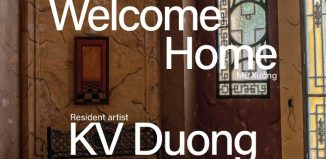KVT – Owl Eyed
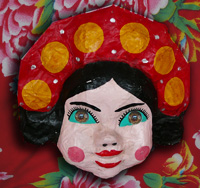 |  |
Click to enlarge
An exhibition by Ly Tran Quynh Giang at the Viet Arts Center is attracting a sizable viewing public. Giang has made a name for herself in Vietnam and overseas and this group of over 20 large paintings makes you realize why.
When I entered the exhibition my first reaction was one of melancholy probably due to the preponderance of deep greens and blues. Big melancholic eyes stared above and around me, followed my movements but only once engaged my eyes directly. Even then the wide owl eyes seemed to stare straight through me in an unnerving way.
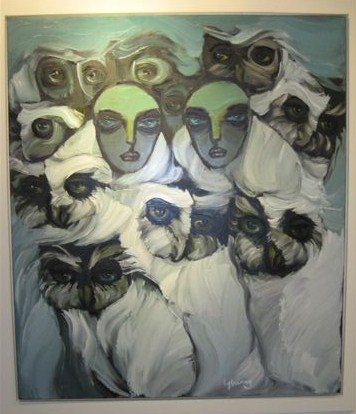
The exhibition title, ‘Hey, are you sick,’ initially flummoxed me. But when you are viewing work as good as this, being a little confused is of no import. Being surrounded by these large, deep portraits is enough to take your breath away. Some of the portraits and/or self portraits seem to have the subjects in white hospital gowns and a couple are titled ’Waiting Room’. These can be taken as literally or as allegorically as you want. I prefer the allegorical as it enables me to do as the artist suggested in an interview on a Vietnamese blog, and put what ever meanings I like into these canvasses so many of them reeking with forlorn loneliness and, in a few, a sense of desolation.
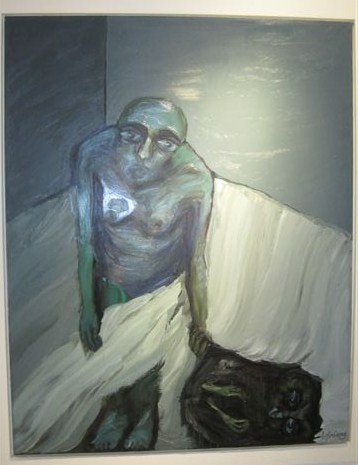
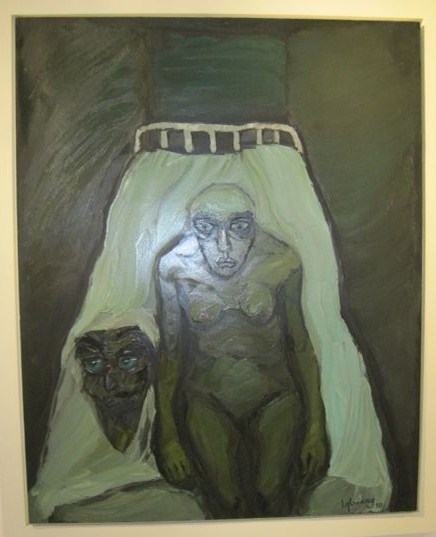
After seeing the program for the opening night I was sorry I hadn’t attended. Dark and emotional piano compositions by Prokofiev, Glinka, Brahms, Scriabin and Rachmaninov were played. The sense of theater would have been superb.
Without the music the drama is still intense.
The recurring motif is the owl. Coming from a European background I tend to read literature and culture with a bias towards the mythologies associated with the Greeks and Romans and those in Judaeo-Christian texts with a sprinkling from the Celts. And really, it’s all a bit of a fowl casserole, with the owl to the Greeks being an incarnation of the goddess Athene and a fount of wisdom. However the Judaeo owl is represented as an associate of Lillith, the Sumarian goddess of death (Giang’s self portrait surrounded by a parliament of owls could well fit Sumerian iconology). Luke, in Christian mythology, re-elevates the bird to its perch of wisdom and bringer of light and unloads from its feathers the weight of satanism. The Celts managed to re-inforce the owl in a female perspective – often the old, wise crone. I tend to like the attribute given to it that says it helps unmask those who would deceive you or take advantage of you. In recent, modern mythology it has become symbolic with the ancient Greek poet Sappho and fragment 147 of her poetry that deals with the joy of venturing, like the owl, into the starry night says ‘Someone will remember us/ I say/ even in another time’.
So pre-armed and conditioned with the above, my interpretations of the paintings were deep and complex indeed, and oh so melancholic, though colored with a redemptive glow that sees women as the wisdom bearers of the future (give or take a tea chest of Sarah Palins here and there).
So there I was reveling in insights when I thought that I should really have a more east Asian look at it all.
Japanese Ainu myths treat the owl as a vessel of trust and reverence as do the Hindus who have a goddess astride a flying owl. But the Buddhist story has the owl being usurped by the swan as the king of the birds because it had more self control. Cross into China and a more sinister aspect evolves while in Vietnam, I’m told, the owl primarily has a negative meaning and is seen as an omen announcing death or illness. My hit and miss research has it that 15th century, Le Dynasty scholar, poet and strategist, Nguyen Trai, said that the invading Wu had owl eyes, meaning suspicious and untrustworthy.
So I revisited the portraits again to re-guess and re-interpret. Are the self portraits of the female morphing into owl – or the owl becoming a literal personification – revelations of the artist’s dual personalities? And are the pictures that show two identical figures representations of the individual’s inner and outer personalities? Are those liquid eyes windows into a soul?
Those viewers besotted with the owls of Harry Potter’s world, or those hooting birds that inhabit a vampirish Twilight, may add their own insights from new, populist mythologies.
It’s an engrossing and intriguing show that remains with you especially those eyes. You can take it in from a surface level and be amazed or you can take on board the ridddles and conundrums that the artist gently passes towards you.
The wide swathes of paint that have been spread over many canvasses, delineate define but also disguise and dissemble the characters and their egos .
It’s a female and feminist show that most females will love and become enmeshed in (add Ariadne and Arachne, two weavers and fine artists who were blessed or damned by the Greek Gods, to the equation). Males should find it all extremely seductive too.

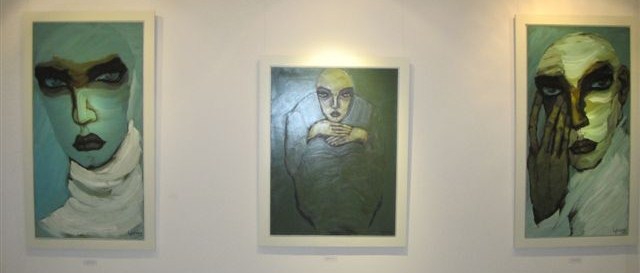
Hurry though because the exhibition closes on the 30th. It’s one of those 2010 experiences that should be had and it’s a great way to celebrate the end the artistic year.
![]()
| Not a reviewer, not a critic, “Kiếm Văn Tìm” is an interested, impartial and informed observer and connoisseur of the Hanoi art scene who offers highly opinionated remarks and is part of the long and venerable tradition of anonymous correspondents. Please add your thoughts in the comment field below. |


